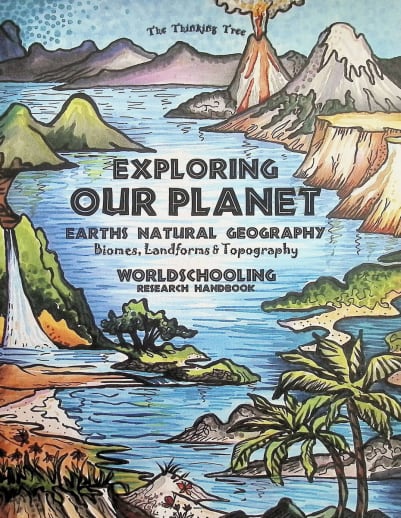Discover amazing places with the Exploring Our Planet geography research handbook. The pages are black and white and not intimidating. There are 32 natural features that will be explored, such as savannas, rivers, lakes, oceans, seas, and more! For each feature, students will write the definition, share interesting facts, learn different climate types, and research what the current state is of this natural feature and who it benefits. Some writing and drawing prompts engage your student with the topic at hand. Thinking Tree is reproducible for family use only and uses the Dyslexia font by Christian Boer, which is less overwhelming for students. A glossary with definitions and examples is included. This book is 195 pages, paperback. ~Amber
Exploring Our Planet Fun-Schooling Science
SKU
043235
ISBN
9781951435646
Grade 3-6
These icons are designed to help you quickly understand and learn important information about our products.
Teaching Method
Traditional
Teacher-centered curriculum commonly used in classrooms that may include a text, teacher manual, tests, etc.
Charlotte Mason
A methodology based on the work of a 19th century educator who maintained that children learn best from literature (Living Books), not textbooks.
Classical
A methodology based on the Latin Trivium (three stages of learning), including the grammar stage (memorization and facts), logic stage (critical thinking), and rhetoric stage (developing/defending ideas).
Unit Study
A thematic or topical approach centered around one topic that integrates multiple subject areas.
Montessori (Discovery)
A methodology based on the work of a 20th century educator that emphasizes student and sensory-driven discovery learning and real-life applications.
Other
Other methodologies
Religious Content
Secular
Contains content contrary to common Christian beliefs (i.e. evolution).
Neutral
Avoids religious or theoretical topics or presents multiple viewpoints without preference.
Christian/Religious
Faith-based or including instructional religious content.
Learning Modality
Auditory
Learns through listening, talking out loud or reading out loud.
Visual
Learns through seeing, prefers written instructions and visual materials.
Kinesthetic/Tactile (Hands-On)
Learns through moving, doing and touching.
Multi-Sensory
Curriculum that employ a variety of activities/components.
Presentation
Sequential
Curriculum progresses through well-defined learning objectives. Emphasizes mastery before moving to the next topic.
Spiral
Topics and concepts are repeated from level to level, adding more depth at each pass and connecting with review.
Conceptual/Topical
Focus is on the “why,” often with a unifying concept as well as specific skills; coverage may be broader.
Teacher Involvement
Low Teacher Involvement
Student-led materials; parent acts as a facilitator.
Medium Teacher Involvement
A mix of teacher-led time and independent student work.
High Teacher Involvement
Teacher-led lessons; may utilize discussions, hands-on activities and working together.
Additional Materials Required
No other materials needed
Everything you need is included.
Other Materials Required
There are additional required resources that are a separate purchase.
Other Materials Optional
There are additional resources mentioned or recommended but are not absolutely necessary.
Consumable
Consumable
Designed to be written in; not reusable.
Non-Consumable
Not designed to be written in; reusable.
Our Price
$24.50 $24.50 $20.95
Rainbow Savings: $3.55
Product Overview
- Geography journal and research handbook for biomes, landforms, and topography
- Thinking Tree uses Dyslexia font by Christian Boer, which is less overwhelming visually for students
- Reproducible for family use
Description
Publisher's Description of Exploring Our Planet Fun-Schooling Science
This research handbook is packed with learning prompts and fun activities that all revolve around the natural features of our planet. The workbook provides 180 pages of learning for of all ages. Studying Earth’s natural geography should be fun and full of adventure and creativity. If any of these types of landforms or bodies of water are within a half day’s drive, GO! Children ages 9+ should be able to work through this book with minimal assistance, younger children will need help with reading, writing and research. This workbook is fun for all ages, and can be used in collaboration with multiple siblings as a family project. Help your child choose safe research materials and documentaries. Use two pages each day to finish this book in one semester, or use one page a day to make the book last a full school year.
Research Topics:
Research Topics:
- Savannas
- Rivers
- Lakes
- Oceans
- Seas
- Waterfalls
- Forests
- Lagoons
- Deserts
- Glaciers
- Ponds
- Streams
- Canyons
- Islands
- Plateaus
- Hot springs
- Plains
- Oases
- Geysers
- Rainforests
- Volcanoes
- Mountains
- Icebergs
- Craters
- Tundra
- Swamps
- Valleys
- Meadows
- Hills
- Caves
- Springs
- Quarries
Details
| Product Format: | Paperback |
|---|---|
| Grades: | 3-6 |
| Brand: | The Thinking Tree |
| ISBN: | 9781951435646 |
| Length in Inches: | 11 |
| Width in Inches: | 8.625 |
| Height in Inches: | 0.5 |
| Weight in Pounds: | 1 |
Videos
Reviews

